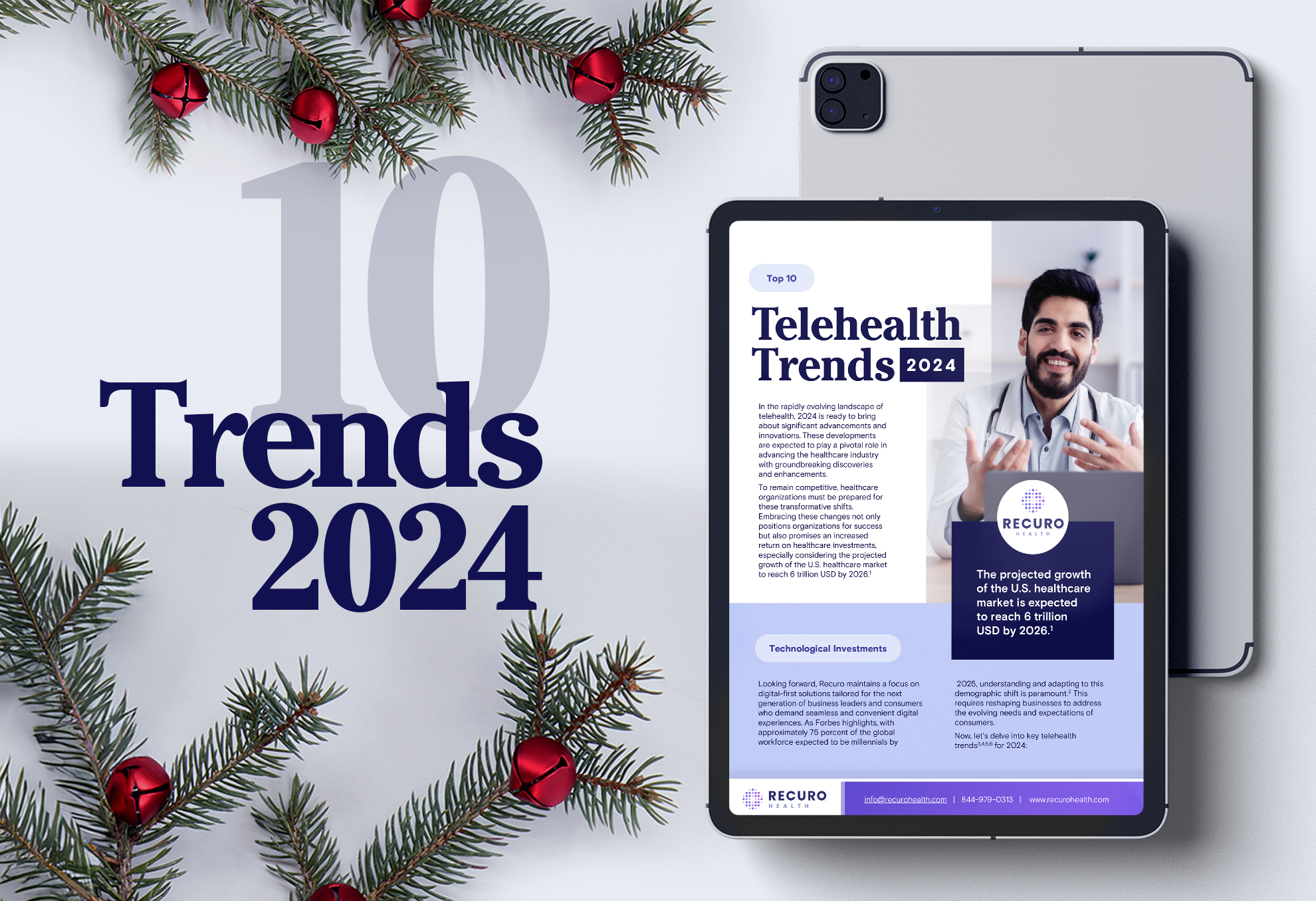
The Telehealth Landscape Is Poised for Remarkable Advancements In 2024
In the rapidly evolving landscape of telehealth, 2024 is ready to bring about significant advancements and innovations. These developments are expected to play a pivotal role in advancing the healthcare industry with groundbreaking discoveries and enhancements. To remain competitive, healthcare organizations must be prepared for these transformative shifts. Embracing these changes not only positions organizations for success but also promises an increased return on healthcare investments, especially considering the projected growth of the U.S. healthcare market to reach 6 trillion USD by 2026.1
Looking forward, Recuro maintains a focus on digital-first solutions tailored for the next generation of business leaders and consumers who demand seamless and convenient digital experiences. As Forbes highlights, with approximately 75 percent of the global workforce expected to be millennials by 2025, understanding and adapting to this demographic shift is paramount.2 This requires reshaping businesses to address the evolving needs and expectations of consumers.
Now, let’s delve into key telehealth trends3,4,5,6 for 2024 by reading below or downloading the whitepaper here.
1. Generative AI In Healthcare:
- While artificial intelligence (AI) is set to play a pivotal role in several healthcare trends, the spotlight falls on generative AI and its far-reaching impact in the coming 12 months. Generative AI is poised to democratize access to transformative AI applications, making implementation and result interpretation more accessible. It achieves this by creating synthetic data, a boon for training medical AI algorithms without compromising patient privacy or when real-world data is insufficient. The applications of generative AI in healthcare are virtually limitless. From facilitating the implementation of transformative AI applications to generating personalized recommendations and creating chatbots and virtual assistants, generative AI stands at the forefront of technological innovation in the healthcare sector.
2. Virtual Assistants & Symptom Checker Chatbots:
- AI-backed virtual assistants and chatbots are gaining popularity in healthcare, providing 24/7 online support for preliminary medical diagnostics and health advisory. These sophisticated applications, operating through voice, text, or option-based inputs, engage in meaningful conversations resembling human interactions. Furthermore, integration with custom patient portals for healthcare institutions enhances their functionality. Beyond their accessibility and utility, chatbots play a crucial role in addressing health concerns, especially during situations where human medical assistants are inaccessible. For instance, during disasters causing call center overloads or non-operational hours, chatbots guide patients in identifying the next steps and encourage them to seek qualified medical assistance when required. Additionally, virtual assistants and chatbots address patient queries about their care and connect them with necessary information for informed decision-making. The integration of these technologies with electronic health record systems and appointment scheduling further streamlines healthcare processes and positively impacts patient health.
3. Wearables and Mobile Apps in Medical Practice:
- Remote health monitoring and wellness apps are on the rise, synchronizing with wearables to collect and analyze health data. These apps, often synchronizing with wearables like pulsometers or fitness trackers, leverage sensor data to report and analyze various health metrics, such as pulse, body temperature, and blood pressure. The synergy between mobile apps and wearables fosters a more personalized approach to healthcare, allowing users to monitor their health conditions actively. The integration of data from wearables empowers individuals to make informed decisions about their well-being. This trend not only encourages proactive health management but also promotes a more connected and engaged patient population.
4. IoT-Powered Virtual Hospitals & Enhanced Telemedicine:
- The convergence of telemedicine and wearable devices within the framework of the Internet of Things (IoT) defines the trajectory of this trend. This Enhanced Telemedicine evolution extends beyond simple remote care delivery, such as remote consultations, towards a holistic approach to remote patient care and treatment. A prime example is the emergence of virtual hospital wards in 2024, where a central location acts as a hub for monitoring multiple patients in the comfort of their homes. This paradigm shift harnesses connected devices to monitor patients remotely, establishing communication channels and facilitating interaction with healthcare professionals. As the healthcare industry embraces this comprehensive approach to remote care, patients can experience a more integrated and personalized healthcare journey, transcending traditional boundaries and leveraging the potential of the IoT.
5. Social Determinants of Health Gain Value:
- In 2024, healthcare providers will pay greater attention to social determinants of health, considering demographic, environmental, and socioeconomic factors in patient evaluations. Going forward into the new year, healthcare providers are poised to increase their attention to SDOH, adopting a more comprehensive approach to evaluating patients’ medical histories. This entails considering factors that have historically received minimal attention.By making additional resources available based on patients’ SDOH predispositions to certain diseases, physicians aim to shift from mere symptom management to proactive prediction and prevention. This strategic shift holds the potential to halt the progression of adverse health conditions and reduce individual medical expenses at the same time.
6. Integration of Healthcare Systems with Big Data & More EHR Integration:
- The healthcare landscape is on the precipice of a data explosion, with an accelerating accumulation of patient records, DICOM files, and medical IoT solutions. As healthcare organizations grapple with the mounting volume of data, the quest for modern platforms, including data fabrics, becomes paramount. These platforms are designed to seamlessly integrate and manage vast quantities of structured and distributed data, a business priority set to dominate the medical landscape in 2024. Enhanced EHR integration emerges as a game-changer, offering healthcare providers streamlined access to patient data. This not only facilitates more coordinated healthcare processes but also empowers patients to access their health information from any device, enhancing the efficiency and convenience of progress tracking.
7. Universal Adoption of Telehealth:
- Telehealth’s journey from emergent practice during the COVID-19 pandemic to universal recognition signifies a seismic shift in healthcare norms. Advanced clinics have seamlessly transitioned to virtual consultations, with this mode of communication poised to gain absolute regulatory approval. Notably, global players such as China have launched national programs to introduce telehealth in public hospitals, reaching an ambitious goal of 70% adoption by 2023. Similarly, the U.S. government is pioneering off-site options to reduce medical facility maintenance costs, aligning with the broader global trend toward telehealth adoption. The impending introduction of 5G wireless technology further opens avenues for rapid growth and universal acceptance of telehealth in the foreseeable future.
8. Overcoming Mental Health Challenges with Telepsychiatry:
- This branch showcased a wide horizon for development as a result of the pandemic, with many people going through a period of psychological devastation that is reflected in clinical statistics—according to pandemic period data (October 2021), over 30% of American adults report symptoms of anxiety or depressive disorder, while earlier surveys suggested that the same indicator was less than 10% in 2019. This burgeoning field addresses a spectrum of mental health issues prevalent in the U.S. population in 2024, including psychological challenges related to the return to in-person work, post-traumatic stress syndrome in healthcare employees, anxiety and depression, multitasking stress, and professional burnout. To confront these challenges head-on, a modern solution takes shape in the form of tele-behavioral health solutions. This innovative solution empowers psychiatrists and psychotherapists to efficiently assist a larger patient population simultaneously, responding to the escalating demand for mental health support in diverse contexts.
9. More Digital Health Unicorns Will Exit via IPO:
- The landscape of cutting-edge healthcare technologies is primarily shaped by ambitious startups introducing transformative innovations. In contrast, large, well-established companies often adhere to established workflows, showing reluctance towards pioneering changes. To break through this competition, startups, often focusing on digital innovation, strive to reach a valuation of $1 billion or more, earning the coveted status of digital health unicorns – entities that are rare and unique. Once these startups solidify their standing, an inevitable decision looms on the horizon – whether to sell the entire project or its shares. While mergers and acquisitions were historically the primary mechanisms for the sale of digital health unicorns, a notable surge in IPO activity was observed in 2019. This shift suggests an increasing preference among startups for IPOs as an exit strategy, potentially stemming from concerns related to monopolization in mergers and acquisitions. This strategic shift enables startups to maintain a level of independence and innovation in the market..
10. Precision Medicine Will Force Out the One-Size-Fits-All Approach:
- Precision medicine, a revolutionary approach integrating patients’ genetics, lifestyle, and environmental data, is poised to challenge the conventional one-size-fits-all paradigm. The latter, based on the parameters of an average patient, often overlooks a myriad of individual variables crucial for accurate diagnostics and treatment efficacy. As we progress into 2024, innovative projects within the precision medicine niche are anticipated to surface, propelling its market worth to an estimated $5 billion. These projects signify a leap toward the universal adoption of precision medicine, calling for cutting-edge informatics technologies that are secure, interoperable, and capable of accommodating diverse diagnostic patterns. This inclusive approach caters to the needs of different organizations and their clients, marking a departure from conventional, generalized healthcare strategies.
What to Expect in Telehealth for the Upcoming Year
In conclusion, the telehealth landscape is poised for remarkable advancements in 2024, with innovations spanning generative AI, virtual assistants and chatbots, more integrated wearables and IoT-powered virtual hospitals, increased data integration, focus on telepsychiatry solutions, and more. Staying informed about these trends is crucial for driving innovation, enhancing the member experience, and positively impacting patients’ lives. When you’re ready to take the next step and partner with a digital care delivery organization like Recuro Health, reach out to our team at [email protected]. We leverage these insights and technological advancements to improve patient outcomes, lower health costs, and more. Reach out to our team today to learn how we can tailor our solutions to your population!
Sources:
- https://www.cms.gov/Research-Statistics-Data-and-Systems/Statistics-Trends-and-Reports/NationalHealthExpendData/Downloads/ForecastSummary.pdf
- https://www.forbes.com/sites/forbescoachescouncil/2022/06/27/millennials-and-gen-z-now-is-the-time-to-reshape-businesses-to-harness-their-power/?sh=13c4caaf5c98
- https://tateeda.com/blog/healthcare-technology-trends
- https://www.forbes.com/sites/bernardmarr/2023/10/03/the-10-biggest-trends-revolutionizing-healthcare-in-2024/
- https://applover.com/blog/telehealth-innovations-and-trends-coming-in-2024/
- https://www.hsph.harvard.edu/india-health-systems/wp-content/uploads/sites/2216/2023/04/Working-Paper-6-Chinas-Internet-Health-Market.pdf









